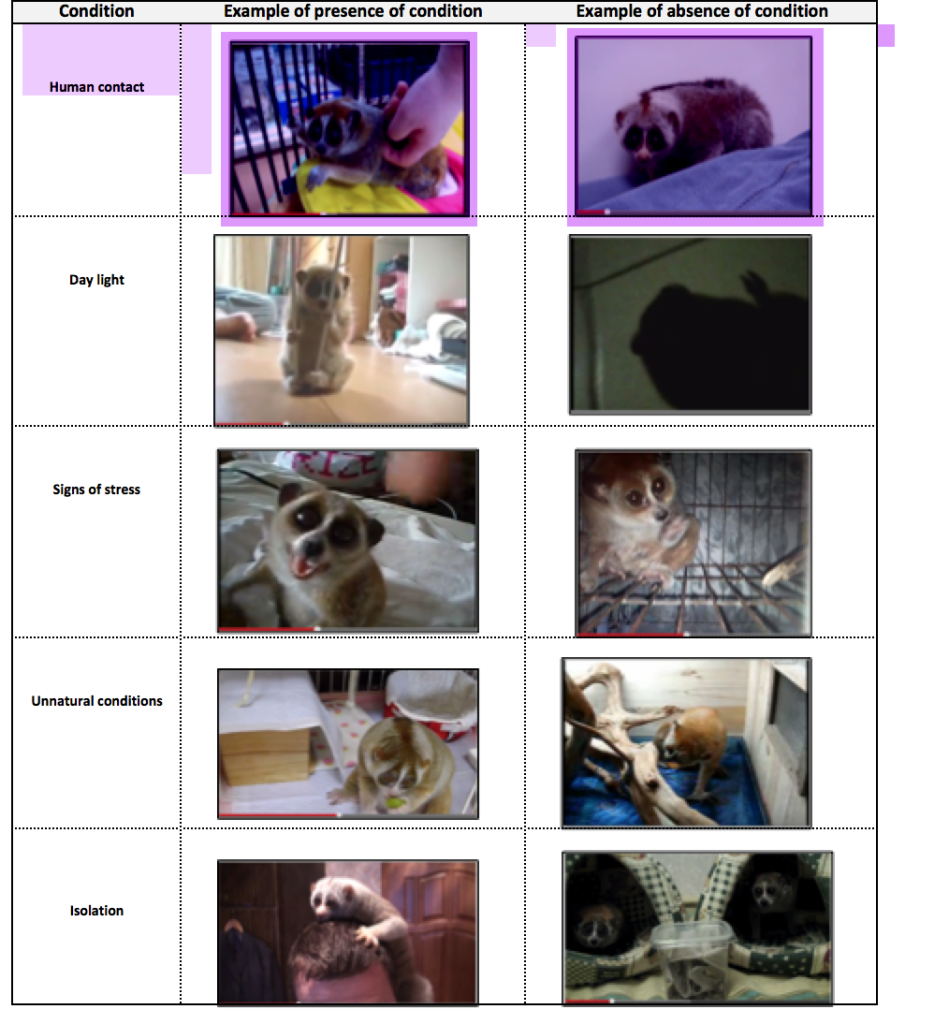by Anna Nekaris
So here it is – a list of what any would-be slow loris conservationist needs to know, and ammunition to apply to the comments sections of YouTube videos…WHY loris videos are cruel. This information is published in the scientific study Is Tickling Torture?
Table 1: images from illegal slow loris videos showing violations of five freedoms of animal welfare – even the ‘good’ images look pretty cruel to me who has seen the lorises’ beauty in its wild habitat! Knowing these animals were stolen from the wild makes it all a bit worse.
Table 2. Violations of the five freedoms in slow loris vidoes.
| Condition | Description of the condition | Why its wrong |
| Human contact | The individual was either; touched, stroked, manipulated, handled or held by a human.
|
Exotic animals are generally unfamiliar with human contact and forced proximity or handling can cause severe stress or discomfort (Morgan and Tromborg 2007). |
| Day light | The individual was observed in daylight or artificial daylight conditions. | Lorises are nocturnal primates and being subjected to day light conditions, without reversing their light cycle or providing adequate night lighting, severely neglects their behavioural needs and impacts their health (Fitch -Synder & Schulze 2001, Nekaris & Bearder 2011). |
| Signs of stress | The individual showed signs of stress: defence threats, crouching, folded mouth, freezing, stereotypic behaviour, attacking (i.e. biting), scratching, scream or chitter vocalisations (Fitch-Snyder and Schulze 2001). | While stress can be considered a necessary requirement in predator avoidance, chronic stress can cause stereotypic and abnormal behaviours, and severely implicate health and psychological well-being (Morgan and Tromborg). |
| Unnatural conditions | Natural substrate or vegetation were not evident throughout the duration of each video
|
Slow lorises are predominantly forest dwelling primates that move by slow climbing and bridging, and have home ranges between 2 and 20 hectares (Nekaris and Bearder 2011). Being housed in small cage enclosures, subjected to an environment which contains no substrate or vegetation does not meet basic slow loris behavioural needs (Fitch-Synder and Schulze 2001, Fitch-Synder 2008). |
| Isolation | Additional slow loris individuals (irrespective of species) were not present throughout the duration of each video. | Primates are social animals (Cowlishaw and Dunbar 2000) and suffer greatly when they are deprived of social interaction or stimuli (Mallapur and Choudhury 2003, Honess and Marin 2006) |
I am asked over and over again why slow loris videos are cruel – do they really show animal cruelty? It is hard to understand the behaviour and nuances of an animal that one has seen possibly for the first time on a video like ‘slow loris eating riceball,’ ‘slow loris being tickled’ or ‘slow loris goes out for a walk.’ But as a person who has studied these animals for more than 20 years – who knows them like Cesar Milan knows his dogs or Monty Roberts knows his horses – I can emphatically tell you that these videos are not only cruel – they break my heart.

